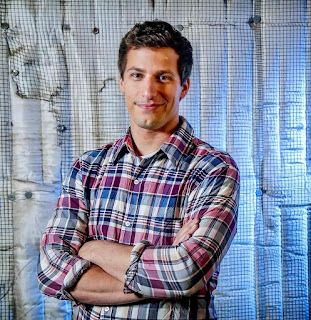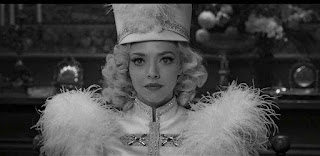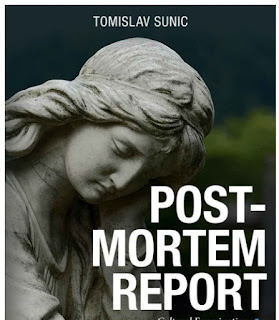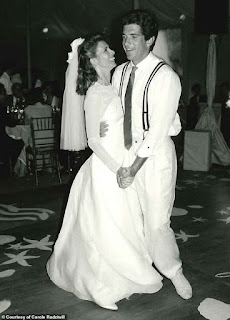
The Academy Awards recently announced inclusion thresholds for Best Picture category, and while promoting Palm Springs, Andy Samberg had a few key words to those who took issue with the very strict, very limiting, very much not doing the least parameters: "The Oscars thing, people having issues with that, it’s insane. The parameters, if you look at them closely, you could have the whitest cast in the history of cinema and still very easily meet them by just doing a few roles behind the camera. People that have problems with it can fuck off."
Samberg and Milioti are wonderful and deserve a lot of credit for their commitment to their roles. The "trope" of two people who seemingly despise each other before magically falling in love has a long history. Consider Rosalind Russell and Cary Grant flinging vicious verbal barbs at one another in "His Girl Friday," all while being sucked into each others' orbit. The question is: "Who else could put up with either one of these people? They're perfect for each other." Falling in love is not what either Nyles or Sarah expected in their lives. After all, back in the real world, Nyles dated Misty, by all appearances a cheating nightmare (although Meredith Hagner is hilarious), and Sarah spends her time self-medicating and covering up her self-pity with a jaded exterior.
"Palm Springs" is genuinely romantic, in a way that sadly feels old-fashioned (but isn't). People get bruised by past experiences in love, and they barricade themselves off from hurt. This becomes a habit, and the habit then becomes your personality. "Wait until the right person comes along" assumes that people stay as open and vulnerable as they were when they were young. But when you've been knocked around by life, love is not necessarily a 100% positive experience. Love comes with other painful things attached: regret, fear, mistrust. "Palm Springs" explores it all. Along with the screenplay,
Palm Springs only manages to pull this off because of the undeniable chemistry shared between Samberg and Milioti. Their dynamics—Nyles’ silly sense of humor and Sarah’s robust cynicism— match for a fantastical love story. The duo is a delight together and manages to lean into both the comedic and dramatic elements that are required of them. Andy Samberg, known more for his comedy skills on SNL than dramatic acting chops, is at his very best here. Source: rogerebert.com

The 2021 Critics Choice Awards nominations announced on February 8 are topped by “Mank” with a leading of 12 bids, followed by the surging “Minari” at 10. “Ma Rainey’s Black Bottom” has eight nominations followed by “News of the World” with seven. “Nomadland,” “One Night in Miami,” “Promising Young Woman” and “The Trial of the Chicago 7”—each reaped six bids while “Sound of Metal” and “Tenet” have five. All of these titles save for “Sound of Metal” make up our predicted Top 10 nominees for Best Picture at the Oscars. “The Midnight Sky” and “The United States vs. Billie Holiday” have three bids, “The Personal History of David Copperfield” and “Pieces of a Woman” got two and in the one nomination category are: “Malcolm and Marie”, “Palm Springs”, “Soul” and “The Way Back”. Winners of the 2021 Critics Choice Awards will be revealed on March 7 during a live CW telecast. This is two days after Oscar nominations voting begins; whose roster of nominations will be revealed on March 15 and the 93rd Academy Awards are announced on April 25. Source: www.goldderby.com

The expression “White guilt,” along with hundreds of similarly ill-defined terms that have sprung up in the USA over the last fifty years, is just an embellished follow-up term of the now defunct Soviet-Speak, which likewise contained a myriad of similar surreal nouns and convoluted phrases, such as “domestic fascist terrorists,” “antifascist struggle,” “economic self-management,” “peaceful coexistence,” “interethnic tolerance,” etc. The Liberal System in the US and EU, along with its legal and academic apparatchiks, is now in the belated process of updating this old Bolshevik language. One must look firstly at the period starting with 1945 and after, a period which brought about not just a new political order, but also marked the beginning of the use of a new sanitized political vocabulary. Defeated Germany bore the brunt of the new notion of the political, although citizens in the victorious US and the UK swiftly followed suit with their own self-flagellating rhetoric. Words such as “colonialism,” “segregation,” “racial distancing,” “apartheid,” and “fascism,” soon became the metaphors for the absolute evil, with “fascism” now denoting pretty much anything to the right of center. Over the last seventy-five years, the West has embarked on a penitential passion play whose effects can be observed today in most media outlets. What is frequently overlooked, however, is that guilt-tripping Whites in the realm of politics has been unfolding hand in hand with a gradual criminalization of the White cultural heritage. The destructive role of the Frankfurt school and its mostly Jewish-Marxist scholars in instilling the concept of White guilt has been amply demonstrated, although the postwar brainwashing of Whites can by no means be attributed to Jewish scholars and activists only. I tried to summarize the history of intellectual purges in Europe, starting immediately after the end of World War, which gradually resulted in the growth of the language of guilt, leading subsequently to suicidal self-denial of millions of White students and politicians in Europe and the US.

As I noted in Homo Americanus: "Particularly harsh was the Allied treatment of German teachers and academics. Since National- Socialist Germany had significant support among German teachers and university professors, it was to be expected that the US reeducational authorities would start screening German intellectuals, writers, journalists and film makers. Having destroyed dozens of major libraries in Germany, with millions of volumes gone up in flames, the American occupying powers resorted to improvising measures in order to give some semblance of normalcy to what later would become “the democratic Germany.” Likewise, French intellectual life from 1944–1950 was similarly depleted of hundreds of anticommunist and nationalist intellectuals suspected of fascist collaboration, with many becoming objects of public shaming. Dominique Venner: Of all professional categories, journalists and writers were hit the hardest. This underlines the ideological character of the conflict and the ensuing purges. The proportion of writers and journalists who were shot, imprisoned, and barred from their profession surpasses all other professional categories. Do we need to be reminded of the assassination of Albert Clément, Philippe Henriot, Robert Denoël, of the suicide of Drieu La Rochelle, of the death of Paul Allard in prison prior to court hearings and of the executions of Georges Suarez, Robert Brasillach, Jean Luchaire […] or the death sentence pronounced in absentia or a commuted prison sentence for Lucien Rebatet, Pierre-Antoine Cousteau, etc.?” From 1950–1990, Western intelligence agencies, with the USA at the helm, had to rely heavily on skills of prominent anti-communist and White nationalist academics and scientists in an effort to contain the perceived Soviet threat.

Putting solely the blame on the liberal media and crypto-communist college professors for generating the culture of White guilt is only partially correct. In order to tentatively elicit a convincing answer regarding the pathology of White guilt one needs to raise some rhetorical questions about Christian teachings. Why are White Christian peoples, in contrast to other peoples of other races and other religions on Earth, more prone to altruism toward non-White out-groups? Why are guilt feelings practically nonexistent among non-White peoples? One answer to these questions may be found in Christian teachings that have made up an important pillar of Western civilization over the centuries. Over the last one hundred years, modern Liberal and Communist elites have aggressively promoted those same feeling of White guilt, albeit in their own atheistic, secular and “multicultural” modalities. Yet the fact remains that the Vatican, the US Conference of Catholic Bishops, the German Bishops’ conference, along with all other Christian denominations in Europe and the US today are the loudest sponsors of non-White immigration to Europe and America, as well as the strongest advocates of White guilt. After the fall of Communism, the same messianic drive to punish those who defy modern Liberal and multicultural scholasticism found its loudest mouthpiece among US neocons and antifa inquisitors. The Jew St. Paul and later on the North African St. Augustin — judging by their own convulsive contrition — suggest that they suffered from bipolar disorder. Paul’s Epistle to the Romans (7:18) may be the key to grasping the modern version of neurotic White self-haters put on display by prominent news anchors and humanities professors today: “And I know that nothing good lives in me, that is, in my sinful nature. I want to do what is right, but I can’t. I want to do what is good, but I don’t. I don’t want to do what is wrong, but I do it anyway.”

Guillaume Faye's criticism of the Western civilization as something that has evolved into a “system that kills peoples,’ his concept of ‘ethno-masochism,’ and his vision of technological progress as something that can be harnessed by nationalism rather than as something to be shunned or prevented. (Faye in this regard runs counter to more popular anti-technological positions adopted by Heidegger, Ellul, and Kaczynski.) A year later, Faye returned to speaking engagements and published Archeofuturism, his response to “the catastrophe of modernity” and an attempt to provide an alternative to traditionalism. Although somewhat welcomed back into the New Right fold in 1998, when he published his edgy The Colonisation of Europe: True Discourse on Immigration and Islam in 2000, Faye attracted considerable hostile media and political attention. Faye was clearly, however, a prophetic and perceptive thinker. He foresaw the gradual replacement of genuine political leaders with “regulators,” adding that the political decisions taken by states are therefore replaced by strategic choices made within the framework of various networks — those of large companies, banking organisations, public or private speculators, etc. All these separate strategies trigger a self-regulation mechanism that allows the System to work towards satisfying its own ends. Source: www.theoccidentalobserver.net



























































